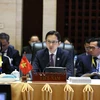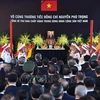Prime Minister Nguyen Tan Dung laid out a series of measures to deal with public debt and bad banking loans by 2020 in his address to lawmakers in Hanoi on November 19.
Prime Minister Nguyen Tan Dung told deputies that public debt grew from 51.7 percent of GDP in 2010 to 60.3 percent in late 2014. It is predicted to account for 64 percent of GDP in 2015, and it will reach 64.9 percent of GDP in 2016 which is still within the limit of 65 percent of GDP set by the National Assembly. The rate will then start reducing in the following years.
By 2020, the amount of public debt should be reduced to 60.2 percent of GDP, and Government debt should account for no more than 46.6 percent of GDP (less than 55 percent of GDP, as regulated), added the PM.
In order to cut public debt to 60.2 percent of the gross domestic product (GDP) and spend approximately 20 percent of the total State budget on debt repayments by 2020, the Government vowed to restructure and closely monitor its debt portfolio and new loans, including Government- and localities-backed loans.
Debt owed to foreign lenders is expected to account for 39.9 percent and 46 percent of GDP in 2014 and 2020, respectively, which is still lower than the limit of 50 percent of GDP limit. The amount of foreign debt payments due in 2014 accounts for 25.9 percent of exports of goods and services.
The Government will ask the State Bank to closely monitor all short-term loans taken out by credit institutions so that from 2015 onwards the rate of foreign debt payment will be brought under the regulated limit of 25 percent of annual exports of goods and services, the PM said.
The expenditure and collection of state budget should be revised towards increased domestic revenue collection. The Government aims to increase the contribution of domestic revenue to 80 percent of the total budget by 2020.
In the meantime, necessary changes to the Laws on State budget and public debt management, as well as other relevant strategies will be made, making it easier to meet debt repayment deadlines.
Regarding the settlement of bad debts, the Government leader said nearly 250 trillion VND worth of non-performing loans (NPLs) had been settled by late October, compared to 465 trillion VND of NPLs in September. This was achieved by collecting, restructuring or selling NPLs to Vietnam Asset Management Company (VAMC).
According to the State Bank, the rate of NPLs stood at 5.4 percent in late September and is forecast to drop to 3.7-4.2 percent this year, compared to 17 percent in September 2012. The total is expected to be within the allowable limits by late 2015.
To speed up the process, the Government is set to continue fine-tuning legal regulations, including those on the function and financial capacity of VAMC, while developing a debt market and enhancing inspections in a joint effort between the State Bank, ministries and localities.
Credit institutions will still undergo restructuring processes, thereby improving their performance and governance, Nguyen Tan Dung said.
The government is also determined to improve the standards of its business climate, which are expected to surpass the ASEAN-6 average in 2015.
To enhance labour productivity, the government will accelerate agricultural restructuring together with building new-style rural areas, introducing new technologies and equipment, upgrading socio-economic infrastructure, improving the quality of the workforce, fine-tuning policies and expanding markets.
Ethnic minorities will also benefit from a programme on rapid and sustainable poverty reduction, the government leader promised.
Reporting on socio-economic performance in October and November, as well as socio-economic development plans for next year, the leader pointed out a 0.2 percent decrease in inflation and a 1.5-2 percent drop in interest rates. During the first 11 months of this year, the country earned approximately 137 billion USD from exports, up by 13.7 percent, while spending 135 billion USD on imports, a rise of 12.6 percent.
During the same period, the industrial production index surged by 7 percent, higher than the 5.6 percent recorded last year. More than 67,200 businesses were registered as new operations, while 23,700 continued their operations, an increase of 7.8 percent.
Over 1.46 million jobs were generated, 91.2 percent of the annual target, which marks an increase of 3.87 percent year-on-year.
Next year, the government will stick to its package of goals, including stabilising the macro-economy, improving the investment climate, and restructuring and strengthening the economy by shifting to new growth models.
Simultaneously, it will also enhance environmental protection and natural resource management while accelerating administrative reforms and ensuring political security and social order.
Later, Nguyen Tan Dung responded to lawmakers’ questions on the Mekong Delta’s economic development, how the national economy capitalises on maritime resources, and policies benefiting ethnic minorities who lack production land.
The Party issued a resolution on maritime strategy and devised an action plan that ensures profitability and national sovereignty over sea and islands, with many promising results recorded so far, he noted.
In response to questions on the Party and State’s policies since China removed its Haiyan Shiyou – 981 rig from Vietnamese waters, the PM said Vietnam wanted to settle differing views on maritime sovereignty in accordance with the 1982 United Nations Convention on the Law of the Sea and other agreements reached in the past.
Vietnam’s position is to firmly protest all acts that run counter to the Declaration on the Conduct of Parties in the East Sea, of which China is a signatory, he affirmed.-VNA
Prime Minister Nguyen Tan Dung told deputies that public debt grew from 51.7 percent of GDP in 2010 to 60.3 percent in late 2014. It is predicted to account for 64 percent of GDP in 2015, and it will reach 64.9 percent of GDP in 2016 which is still within the limit of 65 percent of GDP set by the National Assembly. The rate will then start reducing in the following years.
By 2020, the amount of public debt should be reduced to 60.2 percent of GDP, and Government debt should account for no more than 46.6 percent of GDP (less than 55 percent of GDP, as regulated), added the PM.
In order to cut public debt to 60.2 percent of the gross domestic product (GDP) and spend approximately 20 percent of the total State budget on debt repayments by 2020, the Government vowed to restructure and closely monitor its debt portfolio and new loans, including Government- and localities-backed loans.
Debt owed to foreign lenders is expected to account for 39.9 percent and 46 percent of GDP in 2014 and 2020, respectively, which is still lower than the limit of 50 percent of GDP limit. The amount of foreign debt payments due in 2014 accounts for 25.9 percent of exports of goods and services.
The Government will ask the State Bank to closely monitor all short-term loans taken out by credit institutions so that from 2015 onwards the rate of foreign debt payment will be brought under the regulated limit of 25 percent of annual exports of goods and services, the PM said.
The expenditure and collection of state budget should be revised towards increased domestic revenue collection. The Government aims to increase the contribution of domestic revenue to 80 percent of the total budget by 2020.
In the meantime, necessary changes to the Laws on State budget and public debt management, as well as other relevant strategies will be made, making it easier to meet debt repayment deadlines.
Regarding the settlement of bad debts, the Government leader said nearly 250 trillion VND worth of non-performing loans (NPLs) had been settled by late October, compared to 465 trillion VND of NPLs in September. This was achieved by collecting, restructuring or selling NPLs to Vietnam Asset Management Company (VAMC).
According to the State Bank, the rate of NPLs stood at 5.4 percent in late September and is forecast to drop to 3.7-4.2 percent this year, compared to 17 percent in September 2012. The total is expected to be within the allowable limits by late 2015.
To speed up the process, the Government is set to continue fine-tuning legal regulations, including those on the function and financial capacity of VAMC, while developing a debt market and enhancing inspections in a joint effort between the State Bank, ministries and localities.
Credit institutions will still undergo restructuring processes, thereby improving their performance and governance, Nguyen Tan Dung said.
The government is also determined to improve the standards of its business climate, which are expected to surpass the ASEAN-6 average in 2015.
To enhance labour productivity, the government will accelerate agricultural restructuring together with building new-style rural areas, introducing new technologies and equipment, upgrading socio-economic infrastructure, improving the quality of the workforce, fine-tuning policies and expanding markets.
Ethnic minorities will also benefit from a programme on rapid and sustainable poverty reduction, the government leader promised.
Reporting on socio-economic performance in October and November, as well as socio-economic development plans for next year, the leader pointed out a 0.2 percent decrease in inflation and a 1.5-2 percent drop in interest rates. During the first 11 months of this year, the country earned approximately 137 billion USD from exports, up by 13.7 percent, while spending 135 billion USD on imports, a rise of 12.6 percent.
During the same period, the industrial production index surged by 7 percent, higher than the 5.6 percent recorded last year. More than 67,200 businesses were registered as new operations, while 23,700 continued their operations, an increase of 7.8 percent.
Over 1.46 million jobs were generated, 91.2 percent of the annual target, which marks an increase of 3.87 percent year-on-year.
Next year, the government will stick to its package of goals, including stabilising the macro-economy, improving the investment climate, and restructuring and strengthening the economy by shifting to new growth models.
Simultaneously, it will also enhance environmental protection and natural resource management while accelerating administrative reforms and ensuring political security and social order.
Later, Nguyen Tan Dung responded to lawmakers’ questions on the Mekong Delta’s economic development, how the national economy capitalises on maritime resources, and policies benefiting ethnic minorities who lack production land.
The Party issued a resolution on maritime strategy and devised an action plan that ensures profitability and national sovereignty over sea and islands, with many promising results recorded so far, he noted.
In response to questions on the Party and State’s policies since China removed its Haiyan Shiyou – 981 rig from Vietnamese waters, the PM said Vietnam wanted to settle differing views on maritime sovereignty in accordance with the 1982 United Nations Convention on the Law of the Sea and other agreements reached in the past.
Vietnam’s position is to firmly protest all acts that run counter to the Declaration on the Conduct of Parties in the East Sea, of which China is a signatory, he affirmed.-VNA



















